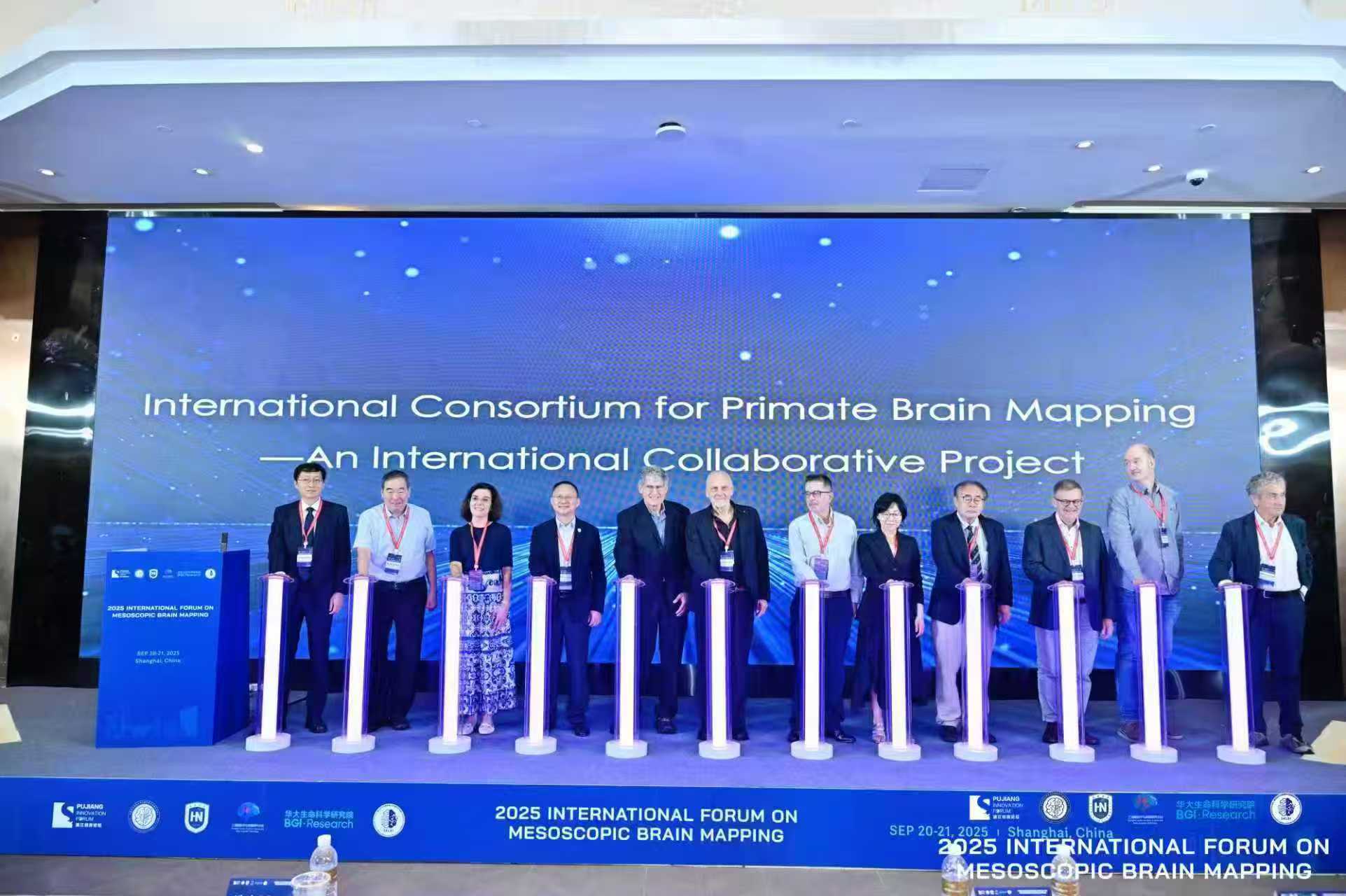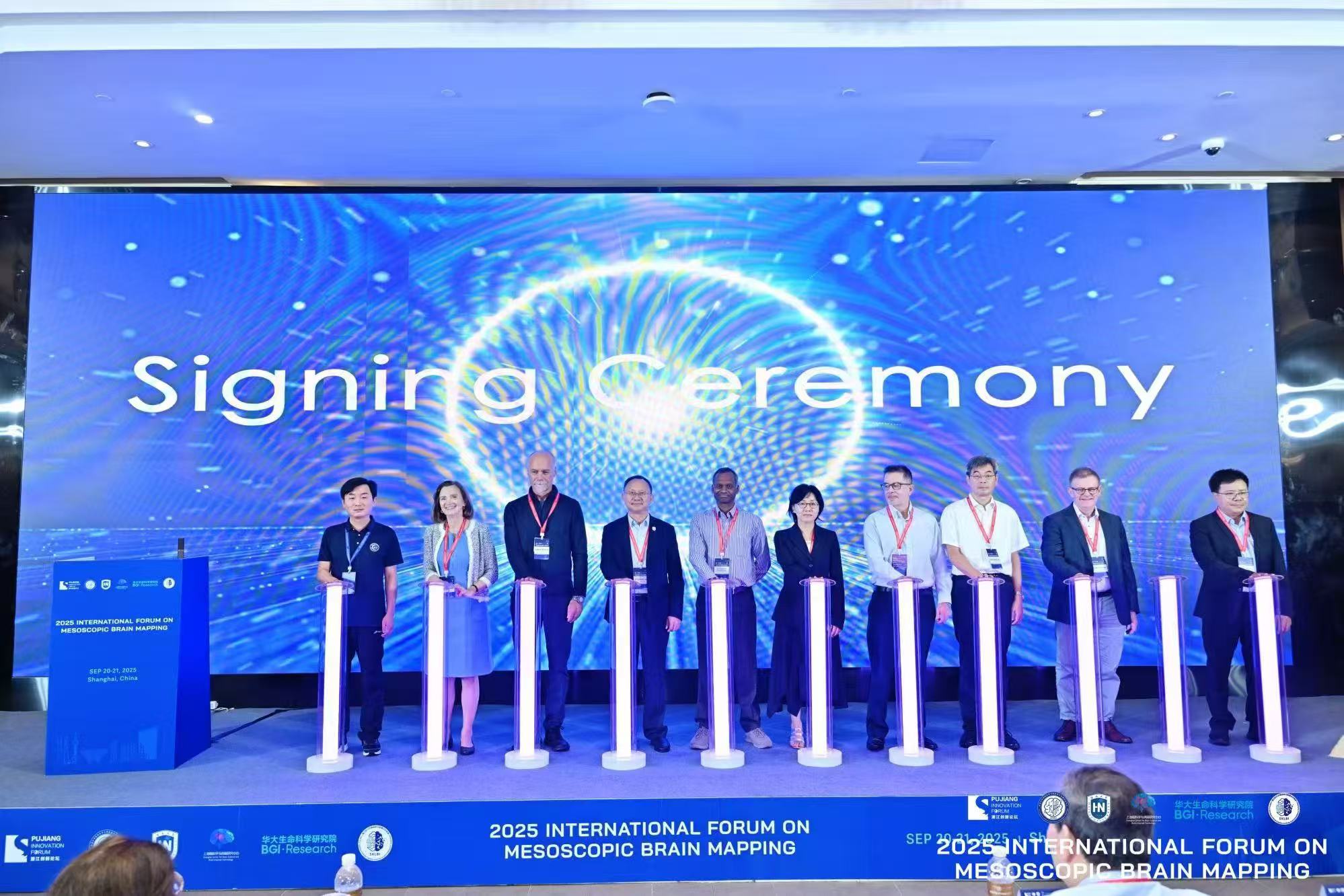In a major step toward unraveling the complexities of intelligence and brain disease, the 2025 International Forum on Mesoscopic Brian Mapping was successfully held in Shanghai as a key segment of the 18th Pujiang Innovation Forum. Co-hosted by the Center for Excellence in Brain Science and Intelligence Technology (Chinese Academy of Sciences), Hainan University, BGI-Research, and Shanghai Center for Brain Science and Brain-Inspired Technology, the event brought together nearly 300 leading experts and scholars from around the world to shape the future of brain science.

2025 International Forum on Mesoscopic Brian Mapping, Shanghai. (Credit: 2025 International Forum on Mesoscopic Brian Mapping organizing committee)
The symposium officially launched the International Consortium for Primate Brain Mapping, with a signing ceremony held among its founding members. Professor Mu-Ming Poo, Academic Director of the Center for Excellence in Brain Science and Intelligence Technology and Chair of the Consortium, outlined the consortium's roadmap and mission. He also unveiled the Consortium's White Paper, representing a major global commitment to the large-scale scientific initiative known as the "Whole Brain Mesoscale Neuroconnectivity Atlas." This initiative aims to integrate international research strengths, facilitate data and technology sharing, and advance exploration in brain science.
This initiative is expected to foster international collaboration in brain science research and accelerate technological advancements. It has already attracted leading research teams from around the globe, spurred multiple technological breakthroughs, and continues to expand its international collaborative network. Researchers have made significant contributions to core technologies and resource integration for mesoscale brain mapping, making them key contributors to this international effort.


International Consortium for Primate Brain Mapping was established. (Credit: 2025 International Forum on Mesoscopic Brian Mapping Organizing committee)
As the executive body for this major project, the Consortium comprises 118 members from 25 countries and regions, including leading institutions such as the Chinese Academy of Sciences, BGI-Research, Fudan University, Tsinghua University, Harvard Medical School, and the Max Planck Society, among other world-class organizations. As a core initiator, BGI contributes its technologies, including spatiotemporal omics, to support this ambitious international project.
A speaker from BGI-Research delivered a keynote speech emphasizing the organization's critical role in supporting the Consortium through fundamental technological advancements. The presentation highlighted recent breakthroughs in single-cell and spatial multi-omics, emphasizing that these technologies are opening new frontiers in brain research by enabling comprehensive analysis of biological systems within their spatial context.
The upgraded Stereo-seq V2 was introduced in this presentation, enabling high-resolution total RNA profiling from clinical FFPE samples, enhancing research into host-microorganism interactions and expanding the scope of spatial transcriptomics. Also showcased was Stereo-cell, a technology enabling in-situ, high-throughput, multi-modal integrated analysis that overcomes the limitations of traditional single-cell methods. It was noted that these innovations will help unravel biological complexities and drive progress across multiple fields of life science.
BGI's commitment to the Consortium is further demonstrated by the participation of its researchers as founding members. Their expertise in genomics, spatial omics, and bioinformatics underscores BGI's commitment to driving large-scale, collaborative neuroscience projects, which provides critical capabilities for integrating diverse datasets and generating comprehensive brain maps.
The symposium also featured an Industry Roundtable, fostering dialogue between academia and industry. Representatives from global leading companies engaged in in-depth discussions on topics such as high-throughput/high-precision whole-brain cell mapping, large-scale high-resolution brain imaging, and massive data processing.
At the same time, BGI’s exhibition booth drew considerable interest with a compelling showcase of its Stereo-omics technology and research-driven multi-omics solutions. The display sparked lively exchanges among researchers, highlighting BGI’s open and collaborative approach to sharing cutting-edge tools and datasets. By making these technologies accessible to the global scientific community, BGI aims to foster open exploration and accelerate collective progress in fields such as brain science, regeneration, and evolution—driving meaningful innovation with a shared commitment to advancing scientific understanding.
The formation of the Consortium marks a significant advance in worldwide scientific partnership, with BGI contributing its pioneering multi-omics technologies and extensive brain science expertise. By integrating global research strengths and cutting-edge analytical platforms, BGI helps provide a foundational resource aimed at comprehensively mapping the primate brain, accelerating the study of neurological diseases, and advancing neural medicine applications across borders. In the meanwhile, BGI is committed to making its data and tools openly available to the Consortium and the wider scientific community, accelerating the pace of discovery.
In the years ahead, the Consortium will prioritize the establishment of unified brain mapping standards, the creation of an open global database for primate brain data, and the acceleration of innovative therapeutic development. Supported by BGI’s advanced multi-omics capabilities and collaborative vision, this international initiative is set to significantly accelerate future research and open new pathways for transformative discoveries in brain science and medical innovation worldwide.



